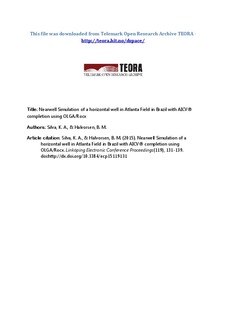| dc.contributor.author | Aparecida Da Silva, Katia | |
| dc.contributor.author | Halvorsen, Britt | |
| dc.coverage.spatial | Brazil | |
| dc.date.accessioned | 2016-03-16T09:03:08Z | |
| dc.date.accessioned | 2017-04-19T12:52:11Z | |
| dc.date.available | 2016-03-16T09:03:08Z | |
| dc.date.available | 2017-04-19T12:52:11Z | |
| dc.date.issued | 2015-11-25 | |
| dc.identifier.citation | Silva, K. A., & Halvorsen, B. M. (2015). Nearwell Simulation of a horizontal well in Atlanta Field in Brazil with AICV® completion using OLGA/Rocx. Paper presented at the 56th Conference on Simulation and Modelling (SIMS 56), October, 7-9, 2015, Linköping University, Sweden. | |
| dc.identifier.issn | 1650-3686 | |
| dc.identifier.uri | http://hdl.handle.net/11250/2438492 | |
| dc.description.abstract | Brazil has special attention in the world oil scenario due its recent findings of oil reservoirs. Most of these reservoirs are heavy oil. The increasing energy consumption and discovery of heavy oil reservoirs require more studies about the extraction of high viscous oil and the related challenges. Besides, the choice for horizontal drilling has being more and more applied in the fields in Brazil. Horizontal wells have shown higher recovery rate and are very suitable for thin oil reservoirs. However, the early water and/or gas breakthrough due to heterogeneities and the heel-to-toe effect is a big challenge. The problem with early water and/or gas breakthrough to the horizontal well can be avoided with new inflow control technology. One of the newest technologies is Autonomous Inflow Control Valve (AICV). The AICV autonomously closes for unwanted fluids as water and or gas, and stay open for oil. In this work, a computational study of a heavy oil (228cP) reservoir in the Santos Basin with 115 m thickness is modeled using Rocx coupled with OLGA. The horizontal well is simulated with both AICV (300 days) completion and openhole with gravel pack completion (200 days). The well has a length of 650m, diameter of 0.24m and is divided into 10 sections. The differential pressure is 20bar. The reservoir is considered heterogeneous with permeability ranging from 5D to 50D. Using AICV completion the valves closes first in the highest permeability zone and then following the heel-to-toe effect. The results confirm that the water breakthrough to the well can be avoided by using AICV completion. The technology will contribute to extend the lifetime of a well and result in reduced costs regarding oil-water separation. | |
| dc.language.iso | eng | |
| dc.publisher | Linköping University Electronic Press | |
| dc.subject | nearwell simulation | |
| dc.subject | Brazil oil reservoir | |
| dc.subject | heavy oil | |
| dc.subject | autonomous inflow control | |
| dc.title | Nearwell Simulation of a horizontal well in Atlanta Field in Brazil with AICV® completion using OLGA/Rocx | |
| dc.type | Journal article | |
| dc.type | Peer reviewed | |
| dc.description.version | Published version | |
| dc.subject.nsi | 512 | |
| dc.source.journal | Linköping Electronic Conference Proceedings | |
| dc.identifier.doi | http://doi.org/10.3384/ecp15119131 | |
